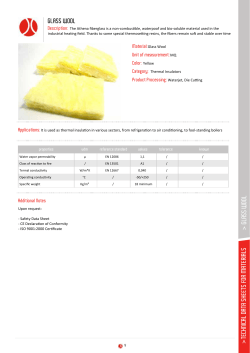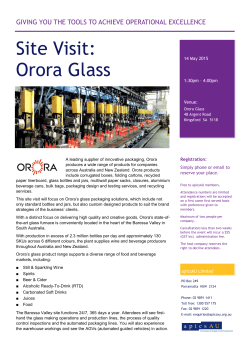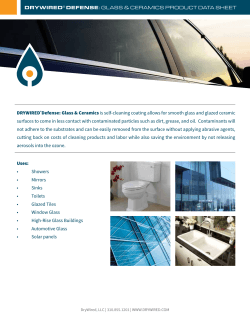
Application of Alpha Inverter in Tempering Furnace
Shenzhen Alpha Inverter Co., Ltd. www.szalpha.com Application of Alpha Inverter in Tempering Furnace I. Introduction With the rapid development of science and technology, tempered glass has become more widely used, and its products have also become more diverse. As a matter of fact, tempered glass has become the major member in the family of glass deep processing and an indispensable important material in people’s lives. Tempered glass has obtained big permanent stress through heating and quenching of glass, so it is also called prestressed glass. In order to eliminate this stress, all you need to do is to heat the glass to a state close to melting. II. Principle and Characteristics of the Tempered Glass 1. The principle of glass tempering process: common high-quality flat glass is put into the tempering furnace after cutting, polishing and washing, and through heating (680℃~715℃) and quenching, a big permanent stress is generated within the glass—the stress on the surface is pressure stress, and the internal stress is tensile stress, i.e., a kind of even and regularly distributed internal stress is generated in the glass. In this way, the intensity and thermal stability of glass is improved. Its production process is: Glass sheet→Examination →Cutting → Snapping →Washing →Drying→Tempering→Examination→ Packing→Putting into storage The tempering process is: Inserting→Heating →Quenching→Slow cooling→Removal 2. Main characteristics of the tempered glass 1) Big mechanical strength: when the tempered glass is under the pressure from load or other external force such as bending or impact, the surface where the force lands receives pressure stress, and the other surface receives tensile stress. With increase of the load, this tensile stress is gradually offset by the original pressure stress on the surface of the tempered glass, until it has been totally offset, it has become tensile stress. Because the compression strength of glass is almost 10 times bigger than its tensile strength, as a result, after tempering, not only the glass surface is strengthened, its weak links are transferred as well. Therefore, when the compression strength and bending strength of tempered glass have increased by 4~5 times, its impact strength will increase by 5~8 times. 2) Great thermal stability: increase of the thermal stability of tempered glass is similar to the increase of mechanical strength, which is also related to the size and distribution of its internal stress. When the glass surface is under rapid heating, its inside is still cool, so that the heated surface is under pressure stress, and its inside is under tensile stress. When the temperature difference is too big and the tensile stress exceeds the tensile strength of the glass, it will cause rupture in the glass. The original pressure stress on the tempered glass surface can offset certain thermal expansion and mitigate the internal tensile stress, so that the thermal stability of the tempered glass can be increased by 1.5~2 times. 3) High safety: starting with a crack, rupture of glass is the result when the crack exceeds the tensile strength. Although the weak spot of tempered glass is at the center (tensile stress area), which generally does not have the defect of microcrack, however, under the situation of high-speed impact or internal stone, a starting point of rupture will be formed on the tensile stress layer; under the impact of tensile stress, the crack extends and transmits to its surrounding area in a very fast way, and multiple crack groups with different sizes are formed. In addition, because tempered glass suddenly ruptures under the closed condition of pressure stress, so during the rupture, its fragments are small cellular particles, which present mesh particles with no sharp edges, so it has great safety performance and it is a type of safety glass. III. Level Track Tempering Furnace Electrical Devices include: 1. It consists of the loading table, heating zone, tempering cooling zone, unloading table, control console and electric control cabinet, of which, the loading table, heating zone, cooling zone and unloading table are all driven by cycloid pinwheel reducer through the chain, and the tempering cooling zone is rapidly cooled by the air blower, where the air duct is installed with up and down air grid to control the finished products rate of glass tempering. 2. Level Track Tempering Furnace Electrical Control System The Level Track Tempering Furnace Electrical Control System mainly consists of the drive motor in the loading table, the drive motor in the heating zone, the drive motor in the cooling zone, the drive motor in Shenzhen Alpha Inverter Co., Ltd. www.szalpha.com the unloading table, motor of the heating and cooling fan, monitoring computer (HMI), PLC, inverter and various field instrument sensor. The automatic level track tempering furnace has multiple control modes such as manual, semi-automatic and automatic. The start, stop and parameter setting of various units of the tempering furnace are all conducted through HMI, and in the meantime, HMI also monitors the operation state of the whole system. As a drive component in the whole control system, Alphas inverter plays a very important role. PLC Host Machine Loading Drive Heating Drive Cooling Drive Unloading Drive Heating Fan Cooling Fan 3. Main application of Alphas inverter in the tempering furnace includes: drive and fan control Drive part: Loading drive motor: four 2.2KW ALPHA5000-32R2GB Heating drive motor: four 2.2KW ALPHA5000-32R2GB Cooling drive motor: four 2.2KW ALPHA5000-32R2GB Bending drive motor: two 5.5KW ALPHA5000-35R5GB Fan part: Heating fan motor: one 250KW ALPHA6000-3250P Cooling fan motor: two 315KW ALPHA6000-3315P Cooling fan motor: two 75KW ALPHA6000-3075P Cooling fan motor: thirteen 7.5KW ALPHA6000-37R5P 4. The control process of Alphas inverter in the level track tempering furnace 1) The drive inverter of the loading table delivers the glass to the heating zone for heating in accordance with the set speed. 2) The drive inverter of the heating zone operates repeatedly in accordance with the set speed to Shenzhen Alpha Inverter Co., Ltd. www.szalpha.com evenly heat the glass. 3) When it reaches the tempering temperature, it enters the cooling zone, and the air blower conducts fast cooling. 4) The drive inverter of the cooling zone operates repeatedly to evenly cool the glass. 5) The drive inverter of the unloading table delivers the glass out to complete the whole process. 6) All inverters are controlled through the bus, and frequency setting and state reading are conducted automatically. 5. Design characteristics of the application of Alphas inverter in the level track tempering furnace 1) Great heat dissipation: Alphas inverter has great heat dissipation performance. 2) Compact structure: Alphas inverter has a compact structure, and its can be installed on the same line. 3) High overload torque: Alphas inverter has higher overload torque. 4) Convenient communication: Alphas inverter has been equipped with modbus communication interface. 5) Powerful function: Alphas inverter has been equipped with encoder interface, which is convenient for closed-loop control of speed. IV. Notes for Alpha Inverter during the Debugging Process of the Level Track Tempering Furnace 1. Various drive inverters have synchronous speed, and the glass is evenly delivered. 2. The inverters in the heating and cooling units operate repeatedly and conduct rapid and accurate stop in accordance with the process requirement, and attention has also been paid to the adjustment of the acceleration time, deceleration time and speed. 3. Control of the cooling fan is vital for product quality. Glass cooling after heating is divided into the two phases of quenching and slow cooling. The basic requirement of glass quenching is fast and even cooling so that the outer surface of the glass presents a pressure state and its inside presents a tensile state. The faster the cooling speed and the bigger the temperature gradient is, the bigger the generated permanent stress, i.e., the bigger the tempered stress. At this moment, the process requires the air volume and air pressure to be established within short time for adequate cooling to achieve the tempering result. If the acceleration time of the fan is too short, the inverter tends to have over-current failure; if the acceleration time of the fan is too slow, it tends to cause unsatisfying tempering result. During the debugging process, attention must be paid to the optimization of inverter parameters. The so-called slow cooling refers to slowly cool the glass to 40℃~50℃ in order to reduce energy consumption and reduce cooling intensity after the glass has finished quenching and the permanent stress has been generated, and then manual unloading can be conducted. 4. Scheme of the ALPHA inverter to control the cooling fan The rotation speed fast-tracking of ALPHA inverter has adopted hardware to accurately measure the rotation speed of motor, the tracking start is very stable, and the tracking start current is small. The great rotation speed fast-tracking function of ALPHA inverter can well satisfy the process requirement to control the cooling fan, and its energy conservation performance is also better than the two-stage control generally adopted by other products. See the following diagram for the speed-power-time curve. Shenzhen Alpha Inverter Co., Ltd. www.szalpha.com Shenzhen Alpha Inverter Co., Ltd. www.szalpha.com As shown in the FIG., the red curve is the speed and energy consumption curve of Alpha. When it stops, at this moment, due to big inertia of the fan, its deceleration is slow, and its air volume can totally satisfy the process requirement, so there is no energy consumption of motor at this moment. Before next quenching, firstly, track the start; at this moment, the start has a high rotation speed and short start time, which can well satisfy the requirement of the quenching process. During the two-stage speed control, after quenching, the inverter has to overcome the big inertia of the fan and reduces to the slow-cooling frequency; at this moment, the motor needs to consume energy. In addition, in next quenching, it has to accelerate from the low slow-cooling frequency to the quenching frequency again. In the FIG., the difference between T2 and T1 is the reduced processing time of Alpha inverter compared with other inverter, and the shadow refers the more energy consumer by other inverter compared with Alpha inverter. 5. Communication of inverter RS485 has adopted the modbus Rtu communication protocol, which can reduce the system cost. However, model selection and installation of the communication cable must satisfy related regulation, otherwise, the communication debugging will have big problem. V. Prospect of the Application of Alpha Inverter in the Level Track Tempering Furnace China is a major manufacturer of flat glass, and after many years of fast development, the flat glass industry has achieved great performance. From the perspective of the whole industry, huge development and many changes have happened on the aspects of production scale, product structure and technical structure. Flat glass enterprises have developed to be more than 200, and China ranks No.1 in its number of flat glass enterprises, the number of float glass production lines and annual output of flat glass. Through long term development and exploration, application of Alpha inverter in the glass processing industry has won great reputation, and it has a very broad market prospect.
© Copyright 2025









